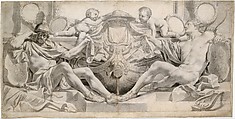Allegory in Honor of Cardinal Richelieu
Charles Le Brun French
Not on view
The long career of Le Brun spans much of the seventeenth century. He owes his reputation to the central role he played during Louis XIV’s reign in designing the décor for major buildings and gardens, especially those of Versailles. In 1634, he enters the studio of Simon Vouet at the suggestion of chancellor Pierre Séguier, where he quickly absorbed the lessons of the master, an influence evident in Le Brun’s earliest works and visible until the end of the 1650s. In 1648, he was one of the twelve founding members of the Académie Royale de Peinture et de Sculpture and was appointed First Painter to the King in 1662, which enabled him to control the entire official production during the years 1660 to 1685.
This highly finished sheet is an early work of Le Brun, drawn in 1641, just before the artist’s departure to Rome with Nicolas Poussin (1642-1645). It prepared the lower part of a larger composition, an engraved thesis by Michel Lasne commissioned by the abbot of Saint-Sernin, the called Jean de Ruzé d’Effiat who dedicated it to the Cardinal Duke of Richelieu. The print, bearing the date 1642, was comprised of three engraved plates that were left unfinished, presumably because that very year the author’s brother Cinq-Mars was executed for treason on the orders of cardinal Richelieu (for proof impressions, see Bibl. Nat. Est., coll. Hennin, t.XXXVI, pp.14-16) . In the seventeenth century, it was common practice to publicly display the conclusions of theses, adorned with printed images glorifying the dedicatee.
In this allegorical composition, Mars and Apollo, portrayed with their attributes, are seated on either side of a ship’s prow, bearing the mantle of a coat of arms which includes a shield surmounted by a ducal crown, above which a cardinal’s hat is supported by two putti. Empty medallions, framed with wreaths, are hung in the background. The naval attributes refer to Richelieu’s role as High Admiral of France while Mars and Apollo symbolize his eminence in the arts of war and peace. The upper part of the thesis engraving depicts the figure of Fame unveiling cardinal Richelieu seated on his throne, the figure of Religion appears beside him while his wisdom and boldness in directing the war are expressed by the figure of Pallas. For this part, a beautiful study of a flying figure of Fame is preserved at the National Gallery of Canada at Ottawa while a black chalk study representing one of the caryatids is in the Morgan Library in New York. Executed on two attached sheets, this balanced and symmetrical composition is remarkable for its degree of finish and detail but also for the pleasing figural proportions of Mars and Apollo. The handling of the lines and the network of finely worked parallel hatchings that shade and model the figure are particularly refined, a precision made possible by Le Brun’s use of black chalk and the tonal and chromatic possibilities of black and grey washes. By creating in this study strong contrasts, especially in the dark shading just behind the figures, the artist transmitted to the engraver the means to convey the impression of a shallow sculpted relief.
Due to rights restrictions, this image cannot be enlarged, viewed at full screen, or downloaded.



